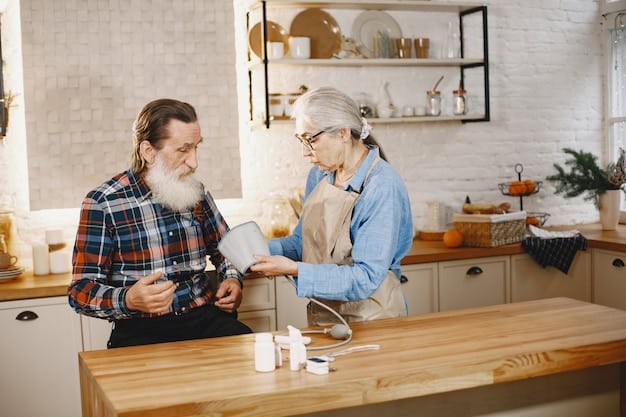Senior Citizen Safety: Emergency Preparedness Guide for Vulnerable Populations

Senior citizen safety during emergencies requires proactive planning and community support to address the unique vulnerabilities faced by this population, ensuring their well-being and resilience in crisis situations.
Ensuring senior citizen safety: protecting vulnerable populations during emergencies is a critical aspect of community well-being, demanding specific strategies and resources. This article delves into the essential steps and considerations for safeguarding seniors during various emergencies, from natural disasters to health crises.
Understanding the Unique Vulnerabilities of Senior Citizens
Senior citizens often face unique challenges that increase their vulnerability during emergencies. These can include physical limitations, chronic health conditions, cognitive impairments, and social isolation.
Physical and Health Considerations
Many seniors have mobility issues that make evacuation difficult. Chronic illnesses may require continuous medication or specialized care. These factors necessitate tailored emergency plans.
Cognitive and Communication Barriers
Dementia or hearing loss can impair a senior’s ability to understand warnings and instructions. Clear and accessible communication methods are crucial.
- Medication Management: Ensuring seniors have access to their medications during an emergency.
- Assistive Devices: Addressing the needs of those dependent on walkers, wheelchairs, or other devices.
- Communication Strategies: Using simple, clear language and visual aids to convey critical information.
Addressing these vulnerabilities requires a multi-faceted approach that encompasses personal preparedness, community support, and technological solutions in order to improve senior citizen safety: protecting vulnerable populations during emergencies.

Creating Personalized Emergency Preparedness Plans
An effective emergency plan should be tailored to the individual needs and circumstances of each senior. This involves assessing potential risks, identifying resources, and establishing communication networks.
Assessing Risks and Needs
Begin by evaluating the types of emergencies most likely to occur in the senior’s area. Consider their specific health conditions, mobility, and support system.
Developing an Action Plan
Outline clear steps for evacuation, sheltering in place, and communication. Include details such as meeting locations, emergency contacts, and transportation options in your emergency plan.
- Evacuation Routes: Planning multiple escape routes and practicing them regularly.
- Emergency Contacts: Creating a list of important phone numbers and sharing it with caregivers and neighbors to ensure senior citizen safety: protecting vulnerable populations during emergencies.
- Shelter Locations: Identifying nearby shelters and understanding their accessibility features.
Regularly reviewing and updating the plan ensures its relevance and effectiveness, making sure all steps are being taken towards senior citizen safety: protecting vulnerable populations during emergencies.
Essential Emergency Supplies and Go-Bags
Having a readily available supply of essential items can significantly enhance a senior’s ability to cope during an emergency. A well-stocked go-bag should include items such as medications, food, water, and personal hygiene products.
Medications and Medical Supplies
Include a supply of prescription medications, over-the-counter drugs, and any necessary medical equipment. Keep a list of medications with dosage and frequency.
Food, Water, and Personal Hygiene
Pack non-perishable food items, bottled water, and personal hygiene products such as hand sanitizer, wipes, and toiletries.
- Water: Store at least a three-day supply of water (one gallon per person per day).
- Food: Choose non-perishable items like canned goods, protein bars, and dried fruit.
- Hygiene: Pack items like soap, toothpaste, and feminine hygiene products in the emergency kit.
Maintaining an up-to-date go-bag and regularly checking its contents is crucial for ensuring that seniors have the necessary resources at their fingertips.
Leveraging Technology for Enhanced Safety
Technology can play a vital role in enhancing the safety and well-being of senior citizens during emergencies. From personal emergency response systems (PERS) to smartphone apps, various tools can provide critical assistance.
Personal Emergency Response Systems (PERS)
PERS devices allow seniors to quickly call for help in the event of a fall, medical emergency, or other crisis. Many systems offer GPS tracking and automatic fall detection.
Smartphone Apps and Communication Tools
Emergency alert apps, weather apps, and communication platforms can provide timely information and facilitate communication with family members and caregivers.
- Emergency Alerts: Apps that provide real-time alerts about severe weather, natural disasters, and other emergencies.
- Communication Platforms: Tools like group texting, video conferencing, and social media can help seniors stay connected with loved ones and receive support in case of an emergency, increasing senior citizen safety: protecting vulnerable populations during emergencies.
- GPS Tracking: Smartphone apps that offer GPS tracking features can help caregivers locate seniors if they become lost or disoriented during an emergency.
Adopting appropriate technological solutions can empower seniors to maintain their independence while ensuring their safety during emergencies, enhancing their contribution to senior citizen safety: protecting vulnerable populations during emergencies.

The Role of Community Support and Collaboration
Community organizations, local government agencies, and healthcare providers play essential roles in supporting senior citizens during emergencies. Collaborative efforts can ensure that seniors receive the assistance they need.
Community Organizations and Local Government
Local community centers and government agencies can serve as valuable resources for seniors during emergencies. They can provide information, shelter, and assistance with evacuation.
Healthcare Providers and Caregivers
Healthcare providers and caregivers can help seniors develop emergency plans, manage medications, and access medical care during emergencies.
- Emergency Shelters: Setting up accessible, senior-friendly emergency shelters.
- Transportation Assistance: Providing transportation for seniors who need help evacuating to ensure senior citizen safety: protecting vulnerable populations during emergencies.
- Educational Programs: Conducting workshops and training sessions to educate seniors and their caregivers about emergency preparedness.
Strengthening community networks and fostering collaboration among stakeholders is crucial for ensuring that senior citizens receive comprehensive support during emergencies.
Staying Informed and Adapting to Changing Conditions
Remaining informed about potential threats and adapting to evolving circumstances are critical components of emergency preparedness. Senior citizens should stay updated on weather forecasts, emergency alerts, and public health advisories.
Monitoring Weather and Emergency Alerts
Seniors should have access to reliable sources of information, such as weather apps, radio broadcasts, and emergency alert systems. Caregivers can assist with monitoring and interpreting these alerts.
Adapting to Changing Conditions
Emergency situations can evolve rapidly, requiring flexibility and adaptability. Seniors should be prepared to adjust their plans as needed and heed the advice of emergency responders.
- Backup Plans: Developing alternative strategies in case the primary plan is no longer feasible for senior citizen safety: protecting vulnerable populations during emergencies.
- Flexibility: Being willing to change course and follow the instructions of emergency personnel.
- Continuous Learning: Staying informed about best practices in emergency preparedness.
By staying informed and adaptable, senior citizens can enhance their resilience and improve their ability to navigate emergencies safely.
| Key Point | Brief Description |
|---|---|
| 🚨 Personalized Plans | Tailor plans to individual needs, risks, and resources. |
| 🎒 Emergency Supplies | Keep essential medications, food, water, and hygiene items ready. |
| 📱 Technology | Use PERS, apps, and communication tools for alerts and support. |
| 🤝 Community Support | Engage with local organizations, healthcare, and caregivers. |
Frequently Asked Questions
▼
A senior’s emergency go-bag should include essential medications, a three-day supply of non-perishable food and water, personal hygiene items, a flashlight, a first-aid kit, copies of important documents, and a list of emergency contacts.
▼
Technology such as Personal Emergency Response Systems (PERS), smartphone apps for emergency alerts, and communication platforms can help seniors stay connected, receive timely warnings, and quickly call for help when needed, improving senior citizen safety: protecting vulnerable populations during emergencies.
▼
Community organizations can provide resources, information, shelter, and assistance with evacuation. They can also conduct workshops and training sessions to educate seniors and their caregivers about emergency preparedness, contributing to senior citizen safety: protecting vulnerable populations during emergencies.
▼
An emergency preparedness plan should be reviewed and updated at least twice a year or whenever there are significant changes in the senior’s health, living situation or local emergency protocols so as to promote senior citizen safety: protecting vulnerable populations during emergencies.
▼
Common barriers include physical limitations, chronic health conditions, cognitive impairments, social isolation, financial constraints, and lack of awareness. Addressing these obstacles requires tailored strategies and community support.
Conclusion
Prioritizing the safety of senior citizens during emergencies requires a comprehensive and collaborative approach. By understanding their unique vulnerabilities, creating personalized preparedness plans, leveraging technology, and fostering community support, we can significantly enhance their resilience and ensure their well-being during times of crisis promoting senior citizen safety: protecting vulnerable populations during emergencies.





